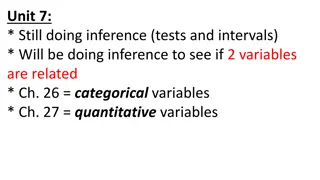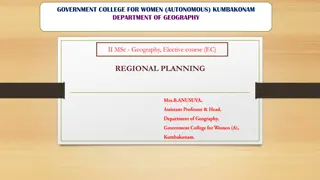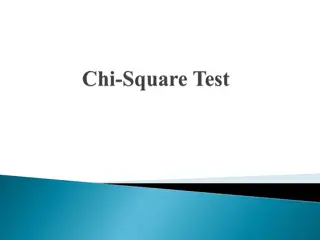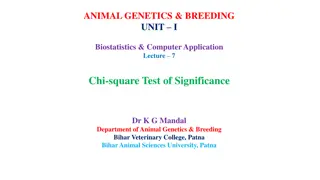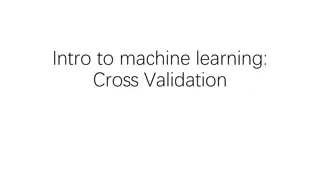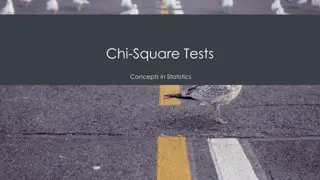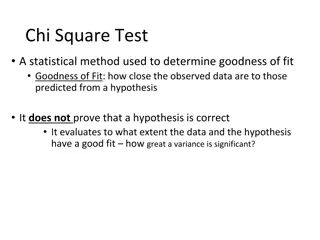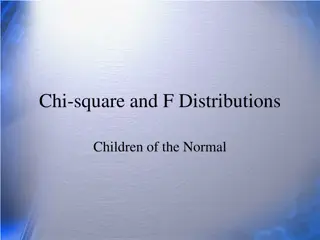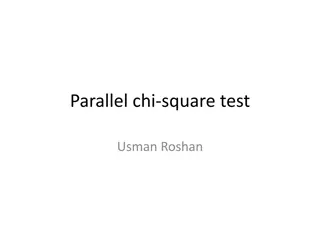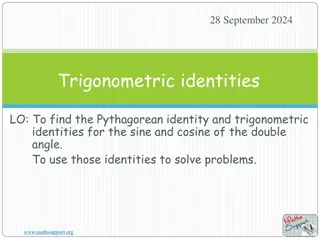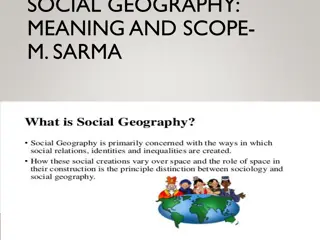Understanding and Using the Chi-Squared Test in Geography
Chi-squared tests in geography are used to analyze associations between variables and goodness of fit to a distribution. This statistical method compares observed frequencies in a sample with expected frequencies. Learn how to apply the Chi-squared test through examples, such as investigating differences in cycling accidents between adults and young people.
Download Presentation

Please find below an Image/Link to download the presentation.
The content on the website is provided AS IS for your information and personal use only. It may not be sold, licensed, or shared on other websites without obtaining consent from the author. Download presentation by click this link. If you encounter any issues during the download, it is possible that the publisher has removed the file from their server.
E N D
Presentation Transcript
Understanding and using the Chi-Squared test in geography
Have you taught chi-squared? Yes lots of times Just once or twice Not yet
What do chi squared tests do? Two sorts Chi squared test for a two-way contingency table tests for association between the variables Chi squared goodness of fit test is for when we think the sample might have come from a particular population distribution Both sorts compare observed frequencies in the sample with expected frequencies
Information to find expected frequencies Observed frequencies OCR A level Biology 2017 Paper H420/02
Two-way table of observed frequencies Can you see how the observed frequencies have been calculated? OCR A level Psychology 2018 Paper H657/01
Robin wants to investigate if there is a difference in the types of cycling accidents between adults and young people. He considered cyclists of age 20 and under to be in the category Young person and cyclists over 20 to be Adult . He categorised the types of cycling accidents as Hit by other vehicle , Hit something stationary , Skidded and Fell off . The counts are in the table below. (i) Use the data to carry out a 2 test, using a 5 % significance level. State clearly your null and alternative hypotheses. Type of Accident Hit something stationary 12 Age Hit by other vehicle 17 Skidded Fell off Totals 4 8 Young person Adult Totals 41 32 49 5 17 7 11 4 12 48 89 OCR Core Maths B, Practice paper
Where do the two types of chi squared tests come up? Goodness of fit AQA Biology AS and A level Edexcel Biology A & B AS & A level OCR A Biology AS and A level AQA A level Geography Edexcel A level Geography OCR A level Geography Two way contingency table Biology AQA A level Geography Edexcel A level Geography OCR A level Geography OCR Core Maths B AQA AS & A level Further Maths Edexcel AS & A level Further Maths OCR A & B AS & A level Further Maths AQA Psychology A level Edexcel Psychology AS and A level OCR Psychology AS and A level Geography Edexcel AS & A level Further Maths OCR A & B AS & A level Further Maths Maths ? Psychology
Visitors to a tourist attraction Age No. of visitors % of UK population this age 23.5 26.4 26.3 23.8 100% A random sample of 50 visitors to a tourist attraction fills out a survey. Does the age distribution of visitors match the age distribution of the population? 0-19 20-39 40-59 60+ TOTAL 19 17 8 6 50
Pebbles on a beach A random sample of pebbles has been collected from 3 locations on a beach. Is the distribution of types of pebble independent of location? Angular or sub- angular 6 13 2 13 8 10 TOT 16 36 Sub- rounded Rounded Well rounded TOT A B C 15 20 27 62 16 15 5 36 50 50 50 150
Free toy car A caf gives a free toy car with each children s meal: red, blue, white, black or silver. Colour Frequency red blue white black silver TOTAL 7 2 4 5 A group of parents meet at the caf regularly with their children they collect data about the free cars. 12 30 Is each colour equally likely what do you think?
Over to you You will work through a Desmos activity designed to help students think about how to decide whether there is enough evidence that all car colours are not equally likely Colour Frequency red blue white black silver TOTAL 7 2 4 5 12 30
Testing whether there is evidence that the car colours are not equally likely Basic idea: Start by assuming that they are equally likely. The technical way of saying this is that the null hypothesis is that all car colours are equally likely. Calculate the expected frequencies you would expect if they were equally likely. Compare observed and expected frequencies.
Hypotheses Null Hypothesis: car colours equally likely Alternative hypothesis: car colours not equally likely Assume null is true and look for evidence in favour of alternative
Degrees of freedom When you were filling in possible frequencies, you could choose values for the 4 colours but the value for the last one had to make the total be 30. There are 4 degrees of freedom 5-1=4
The chi squared test statistic ??? ???2 ??? ?2= If the test statistic is large then this means that the observed and expected values are not close so evidence in favour of alternative hypothesis. What do we mean by large?
The critical value For a chi-squared distribution with 4 degrees of freedom, 5% of the time you would get a value of 9.4877 or larger This is the distribution we would get if the null hypothesis was true
Decision time For the data we had, ?2= 9.668 The critical value (at the 5% level of significance) was 9.4877 9.668>9.4877 so there is evidence that the car colours are not equally likely
What if the colours were not equally likely? The value of the test statistic would generally be bigger The value of the test statistic would generally be smaller There would generally be no effect on the size of the test statistic Not possible to tell
What if the colours were equally likely but the sample size was bigger? The value of the test statistic would generally be bigger The value of the test statistic would generally be smaller There would generally be no effect on the size of the test statistic Not possible to tell
What if the colours were equally likely but fewer colours? The value of the test statistic would generally be bigger The value of the test statistic would generally be smaller There would generally be no effect on the size of the test statistic Not possible to tell
MOVING ON TO TWO WAY CONTINGENCY TABLES
Pebbles on a beach A random sample of pebbles has been collected from 3 locations on a beach. Is the distribution of types of pebble independent of location? Angular or sub- angular 6 13 2 13 8 10 TOT 16 36 Sub- rounded Rounded Well rounded TOT A B C 15 20 27 62 16 15 5 36 50 50 50 150
Pebbles on a beach A random sample of pebbles has been collected from 3 locations on a beach. Is the distribution of types of pebble independent of location? Angular or sub- angular 6 13 2 13 8 10 TOT 16 36 Sub- rounded The distributions are not identical in the samples BUT we are interested in the populations Rounded Well rounded TOT A B C 15 20 27 62 16 15 5 36 50 50 50 150
Lets do some thinking Angular or sub- angular 6 13 2 13 8 10 16 36 Sub- rounded Rounded Well rounded TOT A B C TOT 15 20 27 62 16 15 5 36 50 50 50 150 Assume the three totals of 50 were part of the design of the study Even if different samples had been chosen, these totals would be the same
Testing whether there is independence Basic idea: Start by assuming that there is independence. The technical way of saying this is that the null hypothesis is that the distribution of pebble types is independent of location. Calculate the expected frequencies you would expect if there was independence. Compare observed and expected frequencies.
Calculating expected frequencies Angular or sub- angular A B C TOT 16 36 Sub- rounded Rounded Well rounded TOT 50 50 50 150 62 36 The sample sizes are equal so we would expect equal numbers of each type of pebble from each location. Assume the totals at the bottom represent the distribution on the whole beach.
The expected frequencies Angular or sub- angular 5.33 12 5.33 12 5.33 12 16 36 Sub- rounded Rounded Well rounded TOT A B C TOT 30.67 30.67 30.67 62 12 12 12 36 50 50 50 150 The row totals are equal so each column total is split equally. It is not possible to have part of a pebble but the expected frequencies show what would happen on average so they do not need to be whole numbers. If the row totals were not equal, the column totals would be split in the ratio of the row totals.
Comparing observed and expected frequencies A or SA Obs SR R WR A B C 6 2 8 13 13 10 15 20 27 16 15 5 (Obs Exp)2 Exp A B C A or SA SR R WR 0.083 2.083 1.333 0.083 0.083 0.333 1.554 0.022 1.941 1.333 0.75 4.083 A or SA Exp SR R WR A5.33 1220.6 12 3 7 B5.33 1220.6 12 3 7 C5.33 1220.6 X2=13.683. This is the total of all the contributions to the test statistic 12 3 7
Degrees of freedom () Angular or sub- angular Sub- rounded Rounded Well rounded TOT A B C TOT 50 50 50 150 16 36 62 36 Suppose the totals are fixed and you can put what you like in the other cells (as long as the totals are correct). How many numbers can you choose freely?
Degrees of freedom () Angular or sub- angular Free Free Free Free Sub- rounded Rounded Well rounded TOT Free Free A B C TOT 50 50 50 150 16 36 62 36 Suppose the totals are fixed and you can put what you like in the other cells (as long as the totals are correct). How many numbers can you choose freely?
The probability distribution of the test statistic The horizontal axis shows possible values of the test statistic. The vertical axis measures how likely the value is if the null hypothesis is true. This type of probability distribution is called a chi squared (2) distribution. Chi squared probability distribution 0.16 0.14 0.12 0.1 f(x) 0.08 0.06 0.04 0.02 x 0 0 10 20 30 40
How big is big? Chi squared probability distribution The area under the graph represents probability. The probability that the test statistic is more than 12.59 is 5% (IF the null hypothesis is true). 0.16 The shaded area shows the total probability that the test statistic is more than 12.59 0.14 0.12 0.1 f(x) 0.08 0.06 0.04 0.02 x 0 0 10 20 30 40
X2 = 13.683 = 6 The 5% significance level is often used
Conclusion Our hypotheses were: H0: the distribution of pebbles is independent of location on beach. H1: distribution of pebbles and location on beach are not independent. Our conclusion: 13.683> 12.59 so there is sufficient evidence to suggest the distribution of pebbles is not independent of location on beach.
Interpretation Our test shows evidence of dependence but there is a 5% chance that it could just have been an unusual sample
About the AMSP A government-funded initiative, managed by MEI, providing national support for teachers and students in all state-funded schools and colleges in England. It aims to increase participation in AS/A level Mathematics and Further Mathematics, and Core Maths, and improve the teaching of these qualifications. Additional support is given to those in priority areas to boost social mobility so that, whatever their gender, background or location, students can choose their best maths pathway post-16, and have access to high quality maths teaching.



